

|
Home Updates Hydros Cars Engines Contacts Links ←Previous Next→ Contact On The Wire |
The Oliver's - diesel domination Pt II
|
1951 brought the introduction of the definitive MkII Tiger twinshaft, still with shaft induction but now with the venturi on the left of the motor, parallel crank housings and cylinder fins, priced at £8-18-6. Slightly confusing is the use of RVB again for engine numbers, although we believe that these start from 250 for the MkII. The earlier RV and RVB versions would be retrospectively called the MKI and were to remain on sale alongside the MkII for many months. The new motor was used by Alex Snelling to set several new 2.5cc records, in a series of ever more futuristic cars, ending up at 84.11mph. As a measure of success, Oliver engines finished 1st, 2nd and 3rd in the MG. Trophy race as well as 1st and 2nd in the MCA Nationals. The motors also held all the 2.5cc records, National and Open. On test, the MKII motor produced 0.324bhp at around 15,000rpm, almost double the figures from the original sideport motor. |
|
Another complete car was added to the list in October, with the Alfa available RTR at £15-19-6, but as pointed out in a footnote, only in the twinshaft version. Two months later a near scale Mercedes joined the growing list at the same price.
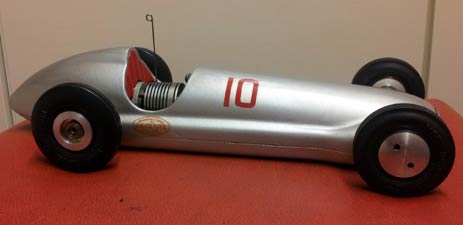 |
 |
| Production Mercedes | Original Howlett version with 'wire wheels' |
|
|
During the year the Olivers produced the first edition of an occasional news sheet called ‘Tiger Tattle’. This was typed and duplicated and as they were at pains to point out, spasmodically produced and a ‘gen’ sheet, not a literary effort. The eight editions are full of technical and product information, tuning and set-up tips and good old-fashioned gossip and cost just 1½d in postage. There was a hiatus between numbers seven and eight, covering the period that the company moved from Nottingham to Ferndown in Dorset, as John Oliver (Engineering) which was to be its home from 1954 to the present day with the (Engineering) being dropped from the name at the beginning of 1989. |
At the Derby Open meeting and couple of other events in 1951, John S appeared with an experimental twin cylinder version of the twinshaft, this time in a teardrop type chassis. Essentially, the 5cc motor comprised two complete Tigers back to back, with a common centre section that also served as the shaft valve for the right hand motor. The cranks of the two motors were set at 180 degrees apart so producing a most impressive noise, and it was no slouch either at around 80mph. Latter, the motor was turned over so that the cylinders faced forward and installed in a semi-scale body.
 |
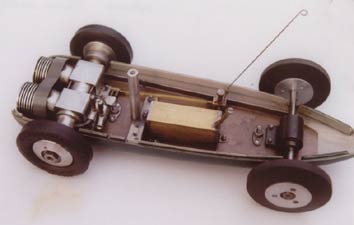 |
|
Twin as originally run and as it is currently with overlapping 'curly carbs' |
|
|
Another entirely functional car, the Tiger Bomb was planned for December, intended originally for continental use with 3.25cc motors. The top and bottom halves were symmetrical, and as the name suggests the shape of a bomb, which left little room internally, so it was planned to cast in the drive axle with pre machined ends, although it was anticipated that conventional twinshafts might find favour in this country. In the end the castings were left plain although there was always some dissention over which was supposed to be the front. |
|
|
|
The Olivers were always willing to embrace developments and ideas from customers, especially the Snelling brothers who were great experimenters and engine builders as well as breaking numerous records with Oliver motors. Indeed the concept of the ‘curly carb’ venturi was credited to Alec Snelling. So successful were the 2.5cc MKIIs that Alec decided to liner one down to 1.5cc, immediately breaking the class record. After a conversation with Alec, JSO produced a prototype set of parts, which were introduced in May as the 1.5cc ‘Cub’ conversion kit for MKII motors at a cost of 48/6. This kit comprised of a new liner, piston, gudgeon pin, contra piston and venturi. It was noted that Cyril Catchpole managed to complete a trackside conversion in around 8 minutes. |
|
Cyril also came up with the ‘Bottoms Up’ concept, using two pans from the ‘Two-Five’ car, which was raced by his wife Joan to great effect, including setting new class records. Oliver adopted the idea with a new casting for top half giving the new car the name ‘Tiger Cub’, although they are still known to this day as ‘Bottoms Up’. New cars were coming thick and fast as another Harry Howlett inspired design, an A6G Maserati joined the line-up of scale bodies. Right: Production version of 'Tiger Cub' with second series pan |
|
In a magazine article it was noted that JSO had been at the forefront of 2.5cc racing for two years, although this did not sit well with everyone, as he was deemed by some to be a ‘works’ entrant and against the spirit of the sport. Certainly, the MCA would not allow anyone from ‘the trade’ to take up a position. He duly won the MG Trophy again, having not competed in 49. It seemed that 64mph was about tops, for his cars, but the Snelling brothers with their highly developed and streamlined cars were using Oliver motors to greater effect, with Eric exceeding 70mph for both his runs at Cleethorpes and JAO very consistent at 64mph for both his.
This would almost appear to be the end of the Oliver’s racing careers as they were content to let their customers take on the mantle of success with their motors, although there are occasional mentions of a ‘J Oliver’ at selected meetings. It is a measure of how pro-active the Olivers were, that in November 1952 they published a detailed set of instructions setting out modifications to the Tiger MkII unit that had brought success to other competitors and also met with their own approval. The drawings included details of metal removal for cranks, crankcases, liners and even drilling the piston to lighten it. There were very precise instructions for assembly and checking to ensure maximum performance, as well as suggestions for exotic fuel brews with as little as 15% oil and a list of ingredients that would now carry several government health warnings. They offered to carry out all this tuning work, test the motor and prepare a report for just £3. If a re-bore and new pistons were required then that was an extra £1 5/-. As with most tuned racing engines, they pointed out that they could not guarantee, or be responsible for results. A final comment on the sheets was that they were experimenting with hard chroming of liners and would offer this as a service if it was successful?
|
Another development in tethered car racing required the company to make new patterns for their cars, and this was the change from the two legged wire bridles to the almost universal ‘pan handle’ attachment. This seems to have started with the Tiger Cub in mid 1952, but new versions of all the cars were available by 1953, and this is a useful tool for establishing possible dates and history for cars and castings that come onto the market. Right: Original second series 'Tiger Two-Five' with 'pan handle' attachment and MkII motor run by P Ridsdale |
|
The early 1950s saw the motors produced by Oliver dominating the 1.5 and 2.5cc Classes throughout Europe with the European, Swiss and Italian championships all won by Oliver engined cars. The only motor that was in challenging the Oliver in anyway was the Supertigre G20. The twinshaft was also being modified and tuned by numerous competitors and installed in all manner of strange chassis configurations.
|
|
Roland Salomon told us that at the start of his career, he was really struggling with below par motors and was on the point of giving up, when his mother asked him what motor he needed to give him a chance. Without fail he replied ‘an Oliver’. Unbeknownst to him, his mother had a relation in England who managed to obtain a motor that was given to Roland on his birthday. From that moment on he never looked back, eventually winning three European Championships in 1.5cc and 2.5cc and both classes at the inaugural World Championship in 1958 using Oliver motors. On September 28th 1958 Roland set a new World record at 150.25kph (93.3mph) with his ‘Killer’ car using an Oliver tuned by Phillip Rochat. Left: Roland Salomon at Basel in 2013 with a replica of the car he used at the same track in 1958 to win the World Championship in the 2.5cc class |
Numerous other national and European Champions were also using Olivers, including Felice Riva and Stan Drayson who was campaigning a car that utilised the motor in a very different way. Ian Moore had come to the conclusion that there were limiting factors with the twinshaft layout, the first being the difficulty in matching tyre sizes to engine revs with the direct drive.
Ian went back to the geared drive, but using bevel gears with the motor in a conventional pan. To address the second issue of frontal area, he also machined the lugs off a single ended motor to enable it to be mounted in an extremely narrow body shell. On seeing this, JS reckoned that it was so thin, it was almost a shadow, and so the car became known as a ‘Shadow’, eventually being sold to Stan Drayson. JS had a version of this car amongst his personal collection.
|
|
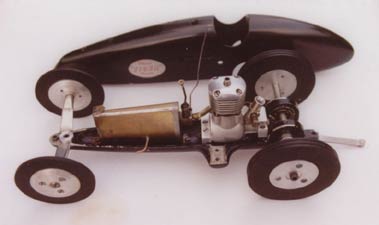 |
| Ian Moore's 'Shadow' | JSOs own version |
|
|
The move away from direct drive resulted in the majority of cars being run using single ended motors on a spur mount in pans and chassis’ designed and built by the individual competitors, such as those used by Roland Salomon, Ken Procter, Les Williamson and Jack Cooke. There were some though such as Jim Dean who stuck with the twinshaft but added intricate gearing systems to both drive shafts with a converted Bottoms Up and his better known 'Incendiary'. A new version of the single ended Tiger, the MKIII had been developed and was for sale at £6-10-0 with the 1.5cc Tiger Cub version 10/- cheaper. The twinshaft was still available however at a relatively pricey £9-18-6, although this was with wheels. Although highly effective, using an aero motor in a spur mount was not ideal and numerous different mounting systems were tried, several that required the mounting lugs to be machined off. |
|
John Oliver produced one of the neatest, elegant and well engineered of these, which combined a twinshaft type centre casting but with axle mounts also cast in. To overcome the long shaft overhangs, the spur pinion was actually inside the front shaft housing. The odd feature of this motor is that it runs in the opposite direction to the aero engine so does it use the crank from a twinshaft? This must have been the pinnacle of integrated design although the concept does not seem to have made it into production with just two known to exist so far. One of these prototype motors was sold in the Christies sale in 2004, the other is in JSOs own Alfa. |
|
This effectively brought the British interest in tethered car racing to a close, yet Oliver motors were still being run in competitions until eclipsed by the arrival of the glow motors. The company continued to develop the Tiger motor adding a 3.5cc version as well as numerous, ‘specials’, one-offs and experimental engines. Oliver motors and their derivatives are still being run in vintage style events, especially in Sweden, and development has seen the records of the 1950s surpassed by a considerable margin.
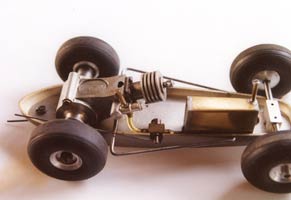 |
 |
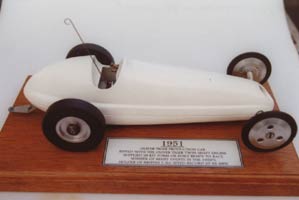 |
| Pumpkin with Battleaxe motor | Alfa Romeo with integral motor/gear/axle unit | 'Tiger Two-Five'. All JSOs personal cars |
©copyrightOTW2016